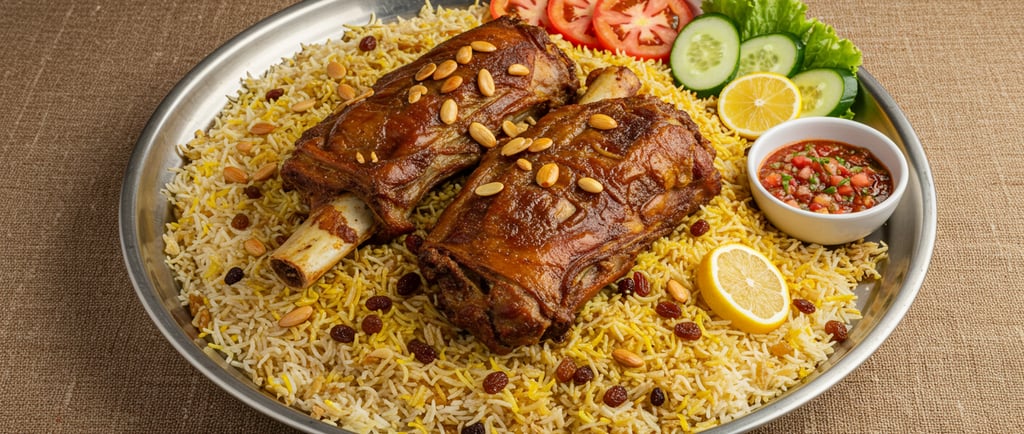Yemeni vs. Omani Cuisine: A Spicy Rivalry
While sharing geographical proximity and historical ties, the cuisines of Yemen and Oman boast distinct identities, each reflecting their unique cultural nuances and environmental landscapes. Though both culinary traditions feature aromatic spices and generous use of meat, a closer look reveals fascinating differences, particularly when comparing two of their most celebrated dishes: mandi from Yemen and shuwa from Oman. This isn't a rivalry of animosity, but rather a testament to the diverse and flavorful tapestry of the Arabian Peninsula.
12/4/20253 min read


Yemeni vs. Omani Cuisine: A Spicy Rivalry
While sharing geographical proximity and historical ties, the cuisines of Yemen and Oman boast distinct identities, each reflecting their unique cultural nuances and environmental landscapes. Though both culinary traditions feature aromatic spices and generous use of meat, a closer look reveals fascinating differences, particularly when comparing two of their most celebrated dishes: mandi from Yemen and shuwa from Oman. This isn't a rivalry of animosity, but rather a testament to the diverse and flavorful tapestry of the Arabian Peninsula.
Mandi: The Subterranean Smoke of Yemen
Originating from the Hadhramaut region of Yemen, mandi is a dish steeped in tradition and a testament to resourceful cooking. The centerpiece is typically lamb (though it can also be goat, camel, or chicken), which is marinated in a blend of aromatic spices known as hawaij. This spice mix often includes cumin, coriander, turmeric, and sometimes cardamom, lending a warm and earthy fragrance to the meat.
The defining characteristic of mandi lies in its cooking method. Traditionally, the marinated meat is suspended on a multi-tiered grid inside a tannour, a subterranean oven lined with hot coals. Below the meat, a pot of basmati rice, often infused with the flavorful drippings from the cooking meat, slowly steams to perfection. The oven is then sealed, allowing the meat to cook slowly under intense heat and the rice to absorb the smoky essence. The result is incredibly tender, fall-off-the-bone meat with a distinct smoky aroma and flavorful, well-cooked rice. Mandi is typically served on a large communal platter, encouraging shared dining and a sense of community.
Shuwa: Oman's Earth-Buried Treasure
Omani shuwa, often considered the national dish of Oman, shares the concept of slow-cooked meat but boasts its own unique preparation and flavor profile. Traditionally made with whole lamb or goat (occasionally beef or camel), shuwa involves marinating the meat in a rich blend of spices. While the specific spice mix can vary by region and family, common elements include coriander, cumin, chili peppers, cardamom, cloves, and sometimes turmeric. The marinade is often applied generously, ensuring the flavors deeply penetrate the meat.
The traditional cooking method for shuwa is what truly sets it apart. The marinated meat is wrapped in banana or palm leaves, sometimes placed in a woven bag, and then buried in an underground sand oven filled with hot embers. This subterranean cooking method, often lasting for 24 to 48 hours, results in incredibly tender meat that practically melts in the mouth. The long, slow cooking process, enveloped in the earth, imparts a unique earthy and subtly smoky flavor to the shuwa. Unlike mandi's focus on the spiced rice cooked below the meat, shuwa is typically served on a bed of rice alongside a tomato-based sauce and is meant to be shared communally during special occasions like Eid.
The Spicy Rivalry: Different Paths to Tender Meat
While both mandi and shuwa celebrate slow-cooked, flavorful meat as the centerpiece, their distinct approaches highlight the nuances of Yemeni and Omani culinary traditions. Mandi emphasizes the smoky infusion into both the meat and the rice through its vertical cooking method within the tannour. The hawaij spice blend offers a specific earthy warmth.
Shuwa, on the other hand, prioritizes the deep penetration of its often more complex spice marinade into the meat, with the extended underground cooking yielding an unparalleled tenderness and a unique earthy note. The rice is typically cooked separately and serves as a base to complement the intensely flavored meat.
The "spicy rivalry" isn't about one dish being superior to the other, but rather an appreciation for the diverse ways in which fire, earth, and aromatic spices can transform simple ingredients into culinary masterpieces. Both mandi and shuwa stand as proud representations of their respective culinary heritages, offering a delicious glimpse into the history, resourcefulness, and communal spirit of Yemen and Oman. Exploring both is not a competition, but a flavorful journey through the heart of the Arabian Peninsula.
